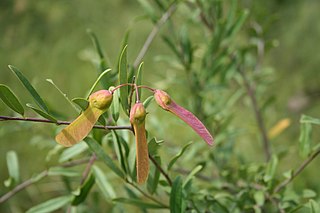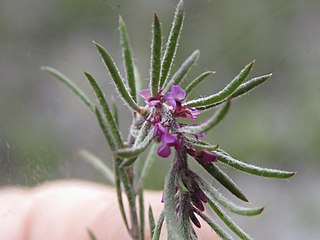
Royal Botanic Gardens, Kew, is a non-departmental public body in the United Kingdom sponsored by the Department for Environment, Food and Rural Affairs. An internationally important botanical research and education institution, it employs 1,100 staff. Its board of trustees is chaired by Dame Amelia Fawcett.

The Polygalaceae or the milkwort family are made up of flowering plants in the order Fabales. They have a near-cosmopolitan range, with about 21 genera and ca. 900 known species of herbs, shrubs and trees. Over half of the species are in one genus, Polygala, the milkworts.

Otto Stapf FRS was an Austrian born botanist and taxonomist, the son of Joseph Stapf, who worked in the Hallstatt salt-mines. He grew up in Hallstatt and later published about the archaeological plant remains from the Late Bronze- and Iron Age mines that had been uncovered by his father.

Alafia is a genus of lianas or climbing shrubs found in tropical Africa and Madagascar. The World Checklist of Selected Plant Families recognises 26 species:

Protea acaulos, also known as the common ground sugarbush, is a flowering plant found in the southwestern Cape Region, South Africa. It is also simply known as ground protea; in the Afrikaans language it is known as an aardroos.

Polygala lutea, commonly known as orange- or yellow milkwort, is a plant in the milkwort family (Polygalaceae) native to pine-barren depressions and swamps in costal areas of the southern and eastern the United States. It was first described in 1753 by Carl Linnaeus.
Moutabea is a neotropical genus of Polygalaceae with about 10 species. It was first described in 1775 by Jean Aublet.

Polygala japonica is a species of flowering plant in the milkwort family (Polygalaceae). It is native to Northeast, East and Southeastern Asia, as well as eastern Australia. It is a wiry and decumbent dwarf shrub with a height between 10 and 25 centimetres. Its stems have tiny curled hairs. Its leaves are 5 to 20 millimetres long and 3 to 10 millimetres wide. Its flowers are purple to mauve and 5 to 6 millimetres long. It flowers between October and December.

Protea effusa, sometimes known as the scarlet sugarbush, is a flowering plant which belongs to the genus Protea. The plant is endemic to the Western Cape province of South Africa. In the Afrikaans language the vernacular name blosrooisuikerbos has been recorded for this plant.

Protea sulphurea, also known as the sulphur sugarbush, is a flowering plant of the genus Protea in the family Proteaceae, which is only known to grow in the wild in the Western Cape province of South Africa. A vernacular name for the plant in the Afrikaans language is heuningkoeksuikerbos.
Muraltia flanaganii is a plant species in the milkwort family (Polygalaceae). It is native to grasslands and moorlands with altitudes between 1,160 and 3,355 metres in southern and eastern Africa. It is a perennial shrub with a height of 20 to 100 centimetres which produces white, pink, or purple flowers. Its leaves are 3 to 8 millimetres long, 0.5 to 1 millimetre wide, and obtuse or apiculate, ending at a needle-like point. The surface of the leaves are glabrous and rough to the touch. According to the Red List of South African Plants, the species is of least ecological concern. It was first described in the Journal of Botany, British and Foreign by Harry Bolus.
Carpolobia is a genus of plants in the milkwort family (Polygalaceae) that are native to Tropical Africa and Madagascar. It was first written about in 1831 by George Don, at which point 4 species were identified. In 1849, the number of accepted species went down to 2. The other 2 became part of the legume family. The two species that remained, C. alba and C. lutea, were described as closely resembling each other. It was initially in the Polygaleae tribe before being split off in 1992 along with the genus Atroxima to form the new tribe of Carpolobieae.
Carpolobia alba is a plant species in the milkwort family (Polygalaceae) that is endemic to rainforests, forest fringes, and savanna-park with altitudes below 400 metres (1,300 ft) in Western Tropical Africa. It is a shrub or small tree which is 3 to 6 metres tall. Its branches are puberulous or shortly pubescent. Its leaves are membranous or slightly leathery. The flowers it produces are yellowish white or white with a crimson spot at the base of upper petals. It produces yellow or scarlet-coloured fruit which are edible and usually contain 3 seeds. It was first described by George Don in 1831. It is used traditionally as a medicine against sexual dysfunction.
Atroxima afzeliana is a species of plant in the milkwort family (Polygalaceae). It is endemic to rainforests and forest fringes with altitudes below 200 metres (660 ft) in Western Tropical Africa. It was first described in 1868 by Daniel Oliver, at which point it was described as a new Carpolobia or a new genera. In 1905, Otto Stapf classified it into the atroxima genera.

Muraltia bolusii is a plant species in the milkwort family (Polygalaceae). It is endemic to sandy coastal flatland with altitudes below 500 metres (1,600 ft) in Western Cape, South Africa. It was first described in 1954 by Margaret Levyns in the Journal of South African Botany. The Red List of South African Plants has listed it as endangered since 2007 due to habitat loss caused by nearby urban expansion, crop cultivation, and sand mining, as well as invasive species. Its population is decreasing.

Protea burchellii, also known as Burchell's sugarbush, is a flowering shrub in the genus Protea, which is endemic to the southwestern Cape Region of South Africa.
Protea witzenbergiana, or Swan sugarbush, is a flowering shrub of the genus Protea.
Protea decurrens, also known as linear-leaf sugarbush, is a shrub of the genus Protea, in the Proteaceae family, which is endemic to the southwestern Cape Region of South Africa. It is a small shrub with a thick underground rootstock, this structure throwing up numerous leafy branches, upon the base of which clusters of flower heads may appear close to the ground. It is pollinated by rodents and grows in low-altitude fynbos or renosterveld.
Gymnospora is a genus of plants in the milkwort family (Polygalaceae) which is endemic to Brazil. It was first described as a subgenus of Polygala by Robert Chodat in 1891. It was separated into its own genera in 2013. Their flowers are 6 to 10 millimetres long and its pedicels are 2 to 8 millimetres long.

Mucuna urens is a species of large liana from the family Fabaceae. The plant is native to tropical Central and South America, and has been introduced into the Republic of the Congo. Common names include horse-eye bean and ox-eye bean.












